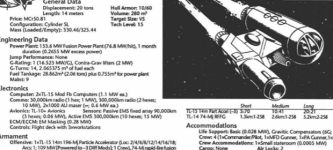Some of you have designed them. Let's talk about them.
Indeed ... some of us
have designed them.

Convincing people of the "value added" is the next step after designing them.
I think of two themes when I think of outriggers. One is "modularity" -- an outrigger could be a flexible design, and you could potentially swap out modules to change its mission. The other is "support", where the outrigger is sometimes a bolt-on to support one specialized mission.
Thoughts? Examples?
I prefer to use the term ... Tug.
Jump Tug.
Maneuver Tug.
Basically what you do is design a ship (or a boat) with "overpowered" engines for its intended purpose (jump/maneuver) which you can then use to compute an external load capacity at reduced drive performance (easier with LBB5, but can also be done with LBB2 designs). Basically, you intentionally design the ship to be "overloaded" in a way that permits the drive performance to "degrade gracefully" in useful quantity amounts.
Like this ...
Code:
Spinward Flex Courier XF-1626621-030000-00002-0 MCr 109.8752 194 tons
batt bearing 1 1 TL=13.
batteries 1 1 Crew=2.
Passengers=0 (1 possible). Cargo=45. Fuel=50.5. EP=11.64. Agility=6. FPP.
Jump-1, Maneuver-5 with 0.1-41.5 tons external cargo added.
Jump-1, Maneuver-4 with 41.6-97 tons external cargo added.
Jump-0, Maneuver-4 with 97.1-105.8 tons external cargo added.
Jump-0, Maneuver-3 with 105.9-218.2 tons external cargo added.
Jump-0, Maneuver-2 with 218.3-465.6 tons external cargo added.
Jump-0, Maneuver-1 with 465.7-1455 tons external cargo added.
Interplanetary Travel (distance, acceleration, time) (link)
Once you have that Jump Tug/Maneuver Tug performance info for "slung loads" available to you, you can then (as a Player and/or as a Referee) start figuring out clever ways of making use of that external load capacity.
For example ... using the my own Spinward Flex Courier design, it's perfectly possible to design 40 ton passenger modules, which would fit into the 40 ton internal cargo bay if needed for an orbit to surface transfer, which has 10 staterooms (8 high passengers 1 steward plus either 1 medic or 1 middle passenger). Use a pair of such modules and the 194 ton starship is reduced to jump-1/maneuver-4 performance and needs 27.4 tons of fuel per jump-1 (50.5 tons internal fuel tankage limit), so it would be best to make use of the inflatable fuel bladder in the internal cargo bay (recommend 8-10 tons) to allow for the additional fuel needed by the power plant during a 2J1 pair of 1 parsec jumps in order to move the entire assembly 2 parsecs, with the remainder of the internal cargo bay remaining open for other cargo transport (~30 tons worth).
An alternative scenario of having only a single 40 ton external cargo load would mean that a 1 parsec jump would require (194+40=234*0.1=23.4) 23.4 tons of fuel per parsec on an internal fuel tankage of 50.5 tons, so 2 parsecs of jump range would require some additional fuel storage in the cargo bay, courtesy of the internal fuel bladder built into the design.
If using the entire 40 tons of internal fuel bladder capacity, it would even be possible to ferry up to 70 tons of external cargo load (194+70=264*0.1=26.4) 3 parsecs at jump-1 and have (50.5+40=90.5-26.4*3=11.3) 11.3 tons of fuel remaining for power plant operations, which at 11.64 tons per 28 days (standard) would have an endurance of (11.3/11.64*28=27) 27 days ... which offers sufficient endurance margin for 3 jumps of 7-9 days when including routine 16 hour drive maintenance after each jump (although fuel reserves will be low after breakout from the 3rd jump-1).
This kind of flexible external load capacity, through interstellar jumps and through interplanetary maneuvers, is the reason why I call the 194 ton starship I've designed the
Spinward Flex Courier ... because that's exactly what it is ... flexible, due to its capacity to operate as both a Jump Tug and as a Maneuver Tug, if the circumstances (and/or business model) call for it.
The logistics of managing the extra displacement external to the starship can get interesting (particularly in a pirate encounter scenario), but the option IS THERE. Other scenarios are of course also possible, such as straight up external cargo loading (I'm thinking Major Cargo Only for this, with Minor and Incidental Cargo requiring internal cargo bay stowage only) ... but that would be a House Rule on the matter, rather than an explicit one written into the Rules As Written (RAW).
The key points I want to make about Tug ships and boats is that Jump Tugs require a jump drive 2+ (which can then operate at reduced performance of 1+) when adding external displacement to hull displacement. Same deal happens with Maneuver Tugs needing a maneuver drive 2+ (so as to operate at 1G+ at reduced performance) when adding external displacement to hull displacement.
Hope that makes sense. :coffeesip:


